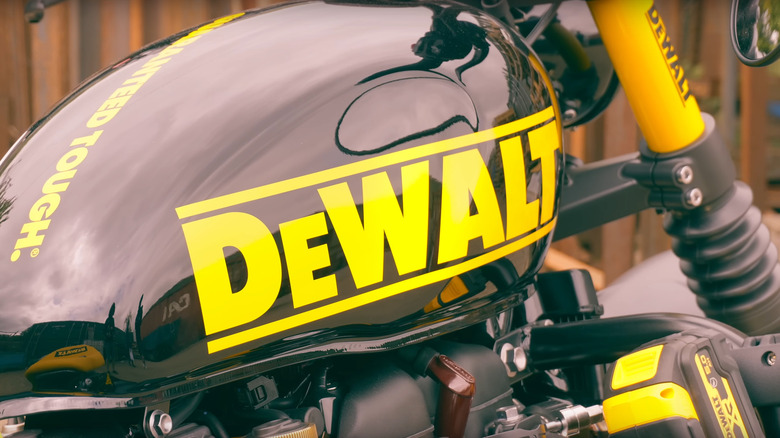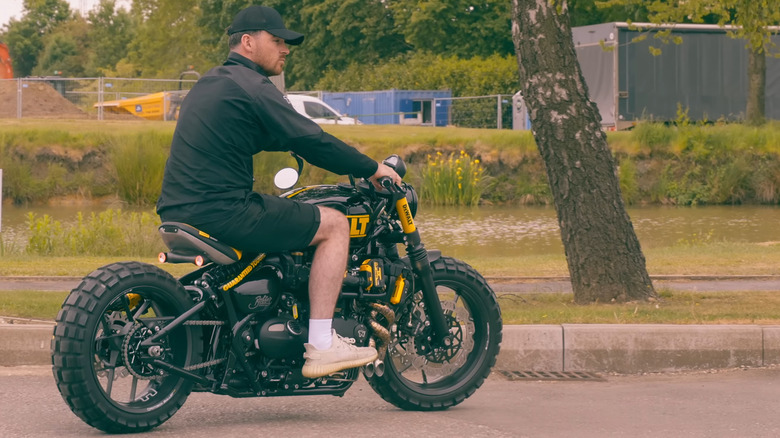Yes, DeWalt Had A Motorcycle Custom Built - Here's What Kind Of Bike It Is
DeWalt recently commissioned the creation of a custom motorcycle that was designed to represent the brand during a company event. The tool manufacturer makes a few products aimed at general automotive repair, but it isn't intrinsically connected to the world of custom motorcycles, so it's natural for fans to wonder who exactly is making this machine.
This wasn't a brand partnership between DeWalt and a major motorcycle manufacturer, like when Gucci partnered with Microsoft to build the most expensive Xbox ever made, but rather a completely bespoke, one-of-a-kind bike that DeWalt commissioned from the custom design shop, Thornton Hundred Motorcycle – giving them only a week and a half to prepare the bike to be showcased at the event. So, while there is a black and yellow DeWalt motorcycle out there in the world, it's probably safe to assume that you won't be seeing any DeWalt-branded bikes appearing at your local dealership anytime soon.
It might be that the peculiarity of this custom design was the point, since the creation of a DeWalt bike appears to have piqued the curiosity of several enthusiasts from the worlds of power tools and custom motorcycles alike. In fact, many of you might be interested in learning a bit more about the Triumph Bonneville T120 1200 that serves as the foundation for this custom machine, as well as the modifications Thornton Hundred Motorcycle made in order to bring it more in line with DeWalt's values of rugged craftsmanship, intentional design, and raw performance.
What kind of bike is the DeWalt Motorcycle?
The bike that ultimately became the DeWalt motorcycle started out as a Triumph Bonneville T120. This might seem like an odd choice to some, given that a large part of the tool company's branding revolves around DeWalt being an American manufacturer and Triumph is a British company, but Thornton Hundred Motorcycle is also based in the U.K., and it appears that this is where the event that the bike was commissioned for took place. Aside from that, fans of the Bonneville T120 know that it's a perfect fit for DeWalt's rugged and industrial aesthetic.
For those who aren't familiar, the Bonneville T120 is a bike that blends classic and modern elements into a low-seated bobber-style design. This bike isn't just about looks either. It also has a sterling reputation for performance, having earned its name by shattering records in the Bonneville Salt Flats back in the 1960s. It's been an iconic symbol of the brand ever since.
The modern iteration used in the DeWalt motorcycle is powered by a 1,200cc liquid-cooled, 8-valve, SOHC, 270° crank angle parallel twin engine with a 97.6 mm bore, an 80.0 mm stroke, and a 10.0:1 compression ratio. This allows the bike to generate up to 79 horsepower at 6,550 RPM and up to 77.4 lb-ft of torque at 3,500 RPM. It has multipoint sequential electronic fuel injection and a 6-speed gearbox. This bike's frame, engine, and transmission remained largely untouched on the custom DeWalt model, but much of the rest of the bike was stripped down and replaced.
What kind of modifications did Thornton Hundred Motorcycles make?
One of the first things that the engineers at Thornton Hundred Motorcycles did when they got to work on the bike was to strip it down to the frame, removing the tank, seat, wheels, and several other major components. Once they had it down to the bones, they started building it back up by swapping in some Rotoblox Bullet Pro aftermarket wheels with heavily treaded tires and wide forks to give the bike a more rugged appearance and set the overall shape. They also added a custom spiraling exhaust and a few other aftermarket features.
But a major factor in making it into a DeWalt bike was to add a large quantity of DeWalt products. The company sent them a large collection of its XR power tools and tasked them with integrating the tools into the newly modified bike's design. So, much of their work beyond this point revolved around finding ways to implement decidedly non-motorcycle components into the new design. They cut a slot into the seat so they could recess one of the DeWalt tool kits directly into it before giving it a custom skin, mounted pivoting Dewalt work lights onto the bike's engine bar brackets, and added custom decals to the new tank, rear hub, and shocks. These yellow additions to the black bike set the tone by giving it the appearance of DeWalt's iconic branding.
Once the base was more-or-less complete, they modeled and 3D printed several custom brackets, and were able to holster several of the tools that DeWalt sent to them, such as the drill, multitool, power screwdriver, and flashlight. After that, all that was left was to make their final adjustments and present the bike to DeWalt for its showcase.

